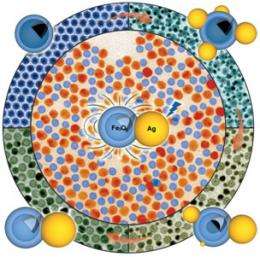In Brief: Bifunctional plasmonic / magnetic nanoparticles

An amorphous-seed mediated strategy has been developed in the Center for Nanoscale Materials Nanophotonics Group at the Argonne National Laboratory for creating bifunctional nanoparticles composed of silver and iron oxide nanodomains. These hybrid particles exhibit unique optical properties due to surface plasmon resonance from the silver and superparamagnetic responses from the iron oxide.
Multicomponent hybrid nanoparticles can exhibit multiple functionalities for applications that are difficult (or even impossible) to achieve from single-component nanoparticles. For example, hybrid noble metal/iron oxide nanoparticles exhibit not only unique optical properties but also magnetic responses. The large-scale synthesis of such hybrid nanoparticles is a challenge.
The keys to success for the new amorphous-seed mediated strategy rely on the precise formation of thin amorphous coatings on the seed nanoparticles and strong interfacial adhesion between the two components within each particle. Such multifunctional hybrid nanoparticles are expected to be useful in surface-enhanced Raman scattering (SERS) for chemical and biological sensing, magnetic/optical dual-modal imaging, and drug delivery.
Collaborations with scientists in the X-Ray Sciences Division and the Electron Microscopy Center at Argonne National Laboratory as well as the University of Illinois enabled detailed characterization of the materials.
More information: S. Peng, C. Lei, Y. Ren, R. E. Cook, and Y. Sun, Angewandte Chemie International Edition, 50, 3158 (2011). DOI: 10.1002/anie.201007794
Provided by Argonne National Laboratory

















